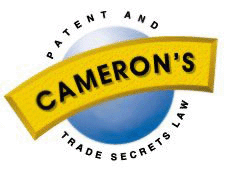
Case Comment
Sakharam D. Mahurkar v.
Vas-cath of Canada Limited et al
citation(s): (1988) 18 C.P.R. (3d) 417 (F.C.T.D. per Strayer J.)
 Case Comment |
Sakharam D. Mahurkar v.
|
copyright 1997-2007 Donald M. Cameron
"The test for anticipation is very rigorous. For a prior document or patent to anticipate a patent whose validity is attacked, the former must be so clear and so apposite as inevitably to lead skilled workmen to the latter."
"It is certainly curious that if this 1882 patent provided all the necessary information it took 99 years for anyone to produce the kind of device depicted in the patent at issue. I appreciate, of course, that in the rarified world of patents, such a banal observation is legally irrelevant to the question of whether an earlier patent is an anticipation of a later patent.
"While obviousness may be established by demonstrating that through a variety of information available to the "inventor" from diverse sources, the "invention" should have been obvious to him and therefore was not truly an "invention", this principle must be applied with great caution."
"While there was, of course, conflicting expert evidence on whether at the time Dr. Mahurkar made his invention it would have been obvious to a skilled technician in the art, I am satisfied on balance that the defendants have not met the burden of proof which lies on them to establish obviousness. I have given the most weight to the evidence of Dr. Uldall and Dr. Mahurkar. They are both medical specialists in this area who had both been engaged in the search for a device which would function for the purposes, and with the success, of the device covered by the patent in issue. Both make it clear in their evidence that there was a recognized problem - the need to have a more satisfactory dual lumen catheter to facilitate continuous hemodialysis - on which various people were working. In other words, the solution was not obvious. While Dr. Muhurkar is of course an interested party and his expert evidence must be viewed with some caution, Dr. Uldall has no interest at stake and his evidence was to the same effect. He was indeed a most persuasive witness. He is generally credited with introducing the technique of using a catheter in the subcalivian vein for this purpose of dialysis. He invented a single lumen catheter for this purpose and then a co-axial double lumen catheter. Before his co-axial lumen catheter had really enjoyed wide-spread sales, however, the Muhurkar catheter as manufactured and sold by Quinton had come on the market. Dr. Uldall testified that he immediately recognized that the Mahurkar catheter was superior to his own. He said that when Dr. Muhurkar first showed him privately some of his earlier prototype catheters, Dr. Uldall was doubtful that they would work because he felt that the inlet holes on the side of the catheter, intended to allow the passage of blood into the inlet lumen, would become blocked by adhesion to the side of the blood vessel. In fact this proved not to be the case. He also recognized the superiority of the double-"D" tubing over his co-axial design but such a structure had not occurred to him for this kind of catheter. If the invention was not obvious to Dr. Uldall, it would not have been obvious to a mere skilled but unimaginative technician."
"He [the Defendant's expert witness] only points out that one can find features of the Mahurkar device in such art, that such features are never found in one place nor are they designed and combined in a way suitable for percutaneous subclavian insertion of a catheter for purposes of hemodialysis."
"No evidence was produced by the defendants to show that the ordinary skilled workman should be assumed to have been aware of all of this prior art. Frankly I find it difficult to believe that several of the items of prior art would have been present to the mind of the ordinary skilled workman in 1981."
"Dr. Uldall made it clear that prior to 1981 there was a problem which various people were seeking to solve, Dr. Mahurkar solved the problem with his device, and that this achievement has been recognized through the rapid adoption of catheters of this type. While evidence of commercial success must be viewed with caution and is often ambiguous, in the present case I find it clear and persuasive."
"It [the patent] does not provide, nor do I think it needs to provide, manufacturing instructions. It shows the configuration required and the purposes are clear. I am satisfied that a skilled workman could take this patent and produce a catheter of that configuration, using his own knowledge to avoid constructions which would be dangerous... I am satisfied that any skilled workman with a mind willing to understand could read this patent and proceed to the fabrication of a safe catheter of this design."
Return to:
Cameron's IT Law: Home Page; Index
Cameron's Canadian Patent & Trade Secrets Law: Home Page; Index